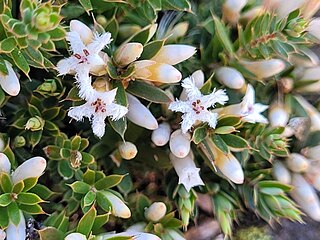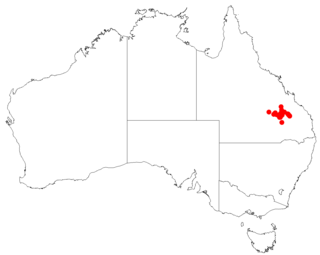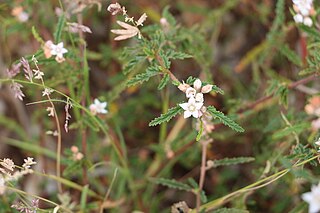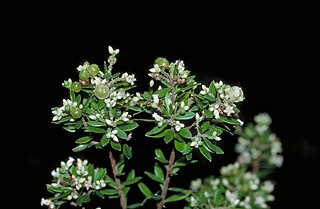
Leucopogon juniperinus, commonly known as prickly beard-heath, is a species of flowering plant in the heath family Ericaceae and is endemic to south-eastern continental Australia. It is an erect, densely-branched shrub with oblong to more or less egg-shaped leaves with the narrower end towards the base, and white, tube-shaped flowers arranged singly in upper leaf axils.

Leucopogon ericoides, commonly known as the pink beard-heath, is a species of flowering plant in the heath family Ericaceae and is endemic to south-eastern Australia. It is a slender shrub with oblong leaves, and white to pinkish, tube-shaped flowers.

Leucopogon obovatus is a species of flowering plant in the heath family Ericaceae and is endemic to the southwest of Western Australia. It is an erect shrub with hairy young branchlets, variably-shaped, simple leaves, and erect clusters of 3 to 15 white, bell-shaped flowers on the ends of branches and in upper leaf axils.

Leucopogon plumuliflorus is a species of flowering plant in the heath family Ericaceae and is endemic to the south-west of Western Australia. It is a weakly erect shrub with egg-shaped leaves and spikes of white or pinkish-white, tube-shaped flowers.

Leucopogon fraseri is a species of flowering plant in the heath family Ericaceae and is native to south-eastern continental Australia and New Zealand, where it is known as Styphelia nesophila, pātōtara, or dwarf mingimingi. It is a prickly, prostrate to trailing or low-growing shrub with egg-shaped leaves, and erect, tube-shaped white flowers usually arranged singly in leaf axils.

Leucopogon muticus, commonly known as blunt beard-heath, is a species of flowering plant in the heath family Ericaceae and is endemic to eastern Australia. It is an erect, straggling shrub with egg-shaped leaves with the narrower end towards the base, and small numbers of white, tube-shaped flowers that are densely bearded inside.

Pultenaea paleacea, commonly known as chaffy bush-pea, is a species of flowering plant in the family Fabaceae and is endemic to eastern Australia. It is a prostrate to spreading shrub with linear to lance-shaped leaves with the narrower end towards the base, and yellow to orange and red to purple flowers.

Styphelia appressa is a species of flowering plant in the heath family Ericaceae and is endemic to south-eastern New South Wales. It is a small, spreading to erect shrub with wiry stems, lance-shaped or narrowly egg-shaped to elliptic leaves and small white flowers.

Styphelia biflora is a species of flowering plant in the heath family Ericaceae and is endemic to eastern Australia. It is an erect to spreading shrub with hairy branchlets, oblong leaves and small white flowers.

Styphelia clelandii, commonly known as Cleland's bearded-heath, is a species of flowering plant in the heath family Ericaceae and is endemic to the south-east of continental Australia. It is weak, open shrub with broadly egg-shaped leaves and white flowers arranged singly or in pairs in leaf axils near the ends of the branches.

Leucopogon costatus, commonly known as twiggy beard-heath, is a species of flowering plant in the heath family Ericaceae and is endemic to southern continental Australia. It is an erect or straggling shrub with broadly egg-shaped, stem-clasping leaves, and white, tube-shaped flowers, the petals densely bearded on the inside.

Leucopogon cuspidatus is a species of flowering plant in the family Ericaceae and is endemic to the central Queensland coast. It is a shrub with densely hairy young branchlets, egg-shaped to lance-shaped leaves with the narrower end towards the base, and white, bell-shaped flowers that are bearded inside.

Leucopogon deformis is a species of flowering plant in the heath family Ericaceae and is endemic to eastern coastal Australia. It is a bushy shrub with narrowly egg-shaped leaves, and white, tube-shaped flowers.

Leucopogon gelidus is a species of flowering plant in the heath family Ericaceae and is native to south-eastern continental Australia. It is a slender, compact shrub with elliptic to egg-shaped leaves, and spikes of drooping, tube-shaped white flowers.

Leucopogon grandiflorus is a species of flowering plant in the heath family Ericaceae and is endemic to Carnarvon National Park in south-eastern Queensland. It is a shrub with softly-hairy branchlets, oblong leaves and white flowers.

Leucopogon lavarackii is a species of flowering plant in the heath family Ericaceae and is endemic to Cape York Peninsula in far northern Queensland. It is a much-branched shrub with softly-hairy branchlets, oblong, elliptic or lance-shaped leaves and spikes of white, tube-shaped flowers.

Leucopogon riparius is a species of flowering plant in the heath family Ericaceae and is endemic to eastern Victoria in Australia. It is an erect shrub with narrowly elliptic to narrowly egg-shaped leaves, the narrower end towards the base, and white, tube-shaped flowers arranged in groups of 3 to 5 in leaf axils.

Androcalva pedleyi is a species of flowering plant in the family Malvaceae and is endemic to south-eastern Queensland. It is low, spreading or prostrate shrub that forms suckers and has softly-hairy new growth, linear to lance-shaped leaves with lobes on the edges, and groups of 7 to 10 white, later pink flowers.

Leucopogon virgatus, commonly known as common beard-heath, is a species of flowering plant in the heath family Ericaceae and is endemic to south-eastern Australia. It is an erect to low-lying shrub with linear to narrowly lance-shaped or egg-shaped leaves, and erect clusters of three to seven white, tube-shaped flowers on the ends of branches and in upper leaf axils.

Leucopogon yorkensis is a species of flowering plant in the heath family Ericaceae and is endemic to Cape York Peninsula in far northern Queensland. It is a shrub or tree with brown, fibrous bark, softly-hairy branchlets, lance-shaped or egg-shaped leaves with the narrower end towards the base, and spikes of small, white, tube-shaped flowers.




















